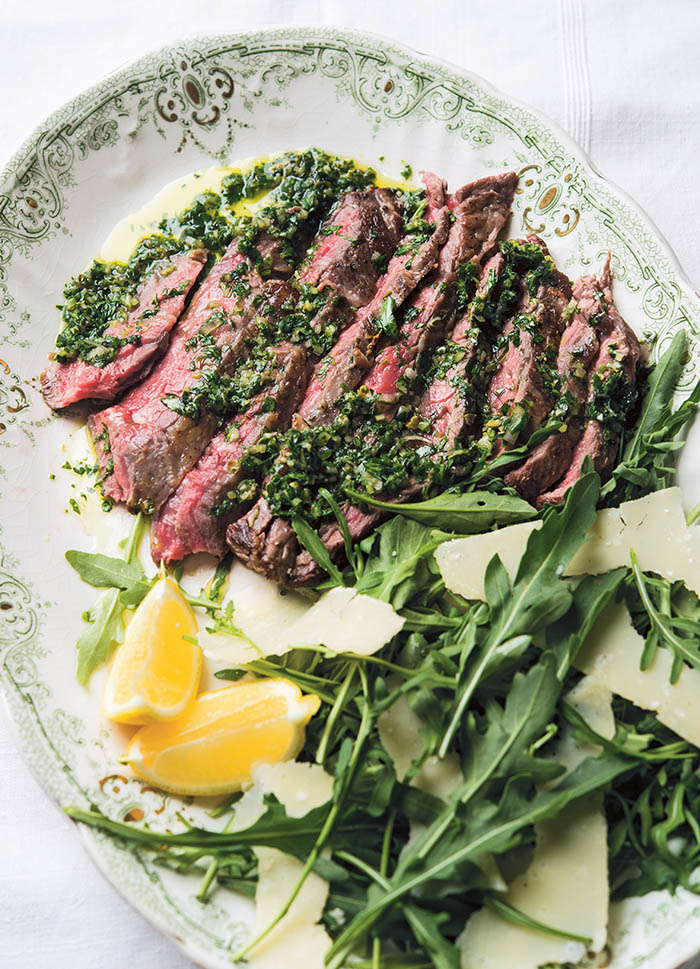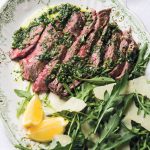
Tagliata is Italian for sliced steak. You’ll find it on nearly every Italian restaurant menu. But it’s easy to make at home, and a great choice for an unfussy meal. (Sometimes it’s also a good way to make one steak feed two.) Often tagliata is served simply with arugula leaves, shaved Parmesan, lemon, and olive oil, but a bright, acidic salsa verde, the Italian green herb sauce, adds bolder flavor. Make the salsa verde with as many herbs as you like, starting with parsley and adding mint, basil, marjoram, and perhaps a touch of rosemary.
Flank steak makes a great tagliata. It’s relatively inexpensive and easy to cook. Skirt steak and sirloin are also good options, but if you’re feeling flush, go with a thick rib-eye. While purists season tagliata only with salt, I’m inclined to make it highly seasoned, using lots of coarsely crushed black pepper as well as garlic and rosemary. Here is the method for cooking the steak in a cast-iron skillet, but grilling over coals is also a good option.
—David Tanis
• ON-DEMAND: Listen to Faith and the gang talk to David Tanis about this recipe, as well as others from David’s book. •
 Excerpted from David Tanis Market Cooking by David Tanis (Artisan Books). Copyright © 2017. Photographs by Evan Sung
Excerpted from David Tanis Market Cooking by David Tanis (Artisan Books). Copyright © 2017. Photographs by Evan Sung
- 1 flank steak (about 2 pounds)
- salt
- black peppercorns
- A few sprigs of rosemary
- 6 garlic cloves sliced
- A chunk of Parmesan, for shaving
- Salsa Verde (see recipe below)
- 1 lemon cut into wedges
- Put the flank steak on a baking sheet and season on both sides with salt. Put a generous handful of peppercorns on a cutting board and crush them by pressing firmly with the bottom of a saucepan (or use a mortar and pestle or a spice mill to achieve a very coarse grind). Measure 1 tablespoon of the crushed pepper and sprinkle it on both sides of the steak.
- Strip the leaves from the rosemary sprigs and sprinkle the meat evenly on both sides with the rosemary and garlic slices. Drizzle the olive oil over both sides of the steak, then massage it with your hands to distribute the seasonings, pressing the pepper, rosemary, and garlic onto the surface. Let the steak stand at room temperature for an hour (or refrigerate for several hours; bring to room temperature before proceeding).
- Meanwhile, place a cast-iron skillet large enough to hold the steak (or a heavy roasting pan) on the upper rack of the oven and heat the oven to 450 degrees.
- Let the pan heat for at least 30 minutes.
- Carefully put the flank steak in the pan and close the oven door. After 5 minutes, flip the steak (it should be well browned on the bottom) and cook for 2 to 3 minutes, just until juices appear on the surface and a thermometer registers 120 degrees for rare, or for a few minutes more for medium-rare meat. Transfer the steak to a carving board and let rest for 10 minutes.
- Cut the meat on a diagonal, against the grain, into 1/4-inch-thick slices. Arrange the meat on a large platter and surround with the arugula. With a vegetable peeler, shave about 2 ounces of cheese over the arugula. Serve with the salsa verde and lemon wedges.
Salsa Verde (Green Herb Salsa)
Makes 1 cup
Garlic clove
Salt
2 anchovy fillets, roughly chopped
1 teaspoon roughly chopped capers
3/4 cup fruity extra virgin olive oil
1/2 cup finely chopped flat-leaf parsley
2 tablespoons finely chopped mint
1 small shallot, minced
1 teaspoon grated lemon zest
1 tablespoon lemon juice
Put the garlic in a mortar with a pinch of salt and pound to a paste. Add the anchovies and capers and roughly mash them. Stir in the olive oil, parsley, mint, shallot, and lemon zest. (You can make the sauce to this point up to several hours in advance.)
Just before serving, stir in the lemon juice. (Don’t add it earlier or your bright green sauce will fade.) Taste and adjust the seasoning.


